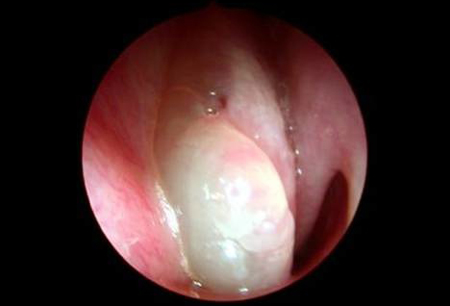Tests
1st tests to order
anterior rhinoscopy
Test
Visualization is essential for a diagnosis of nasal polyps to be made.[2] Unilateral polyps are suspicious of a neoplasm and are investigated with CT imaging and biopsy.[25][26][Figure caption and citation for the preceding image starts]: Grade 3 nasal polypsFrom the collection of Dr Richard Hewitt [Citation ends].
Result
polyps visualized
nasal endoscopy
Test
May be required if polyps are not seen on anterior rhinoscopy. Visualization is essential for a diagnosis of nasal polyps to be made.[2] Advised when facial pain is the main symptom.[2] Unilateral polyps are suspicious of a neoplasm and are investigated with CT imaging and biopsy.[25][26]
Result
relevant pathology in the middle meatus (thick secretions, pus, polyps, edema, etc.)
Tests to consider
CT sinuses
Test
Undertaken if there are unilateral signs and symptoms or other features suggestive of neoplasia such as bleeding, crusting, cacosmia (perception of foul odor), periorbital edema, displaced globe, impaired vision, ophthalmoplegia, severe frontal headaches, frontal swelling, signs of meningitis or focal neurology, or systemic signs of neoplasms such as weight loss.
Also undertaken if surgical intervention is being considered as part of the pre-operative workup.[2]
Result
polyps visualized and extent defined
biopsy
Test
Indicated if there are concerns about alternative diagnoses, particularly neoplasia.[2] Undertaken if there are unilateral signs and symptoms or concerning features such as bleeding, crusting, cacosmia (perception of foul odor), periorbital edema, displaced globe, impaired vision, ophthalmoplegia, severe frontal headaches, frontal swelling, signs of meningitis or focal neurology, or systemic signs of neoplasms such as weight loss. Histology may change the diagnosis in 1% of surgically removed nasal polyps.[33]
Result
confirms histology
nasal smear and culture
Test
A nasal smear demonstrating the presence of eosinophils is typical in chronic rhinosinusitis with nasal polyps, but may also be seen in allergic rhinitis and nonallergic rhinitis with eosinophilia syndrome. Nasal swabs/nasal mucus culture may be beneficial in revealing secondary bacterial infection, although Staphylococcus aureus carriage in the nose is very common.[2][27]
Result
presence of eosinophilia and positive culture for organisms
CBC with differential
Test
A CBC is indicated in patients with rhinosinusitis. Patients with chronic rhinosinusitis with nasal polyps often have a peripheral blood eosinophil count at the upper end of the normal range or modestly elevated. Levels of 0.4 × 10⁶ cells/L up to 1.5 × 10⁶ cells/L may be seen, with higher levels in patients with asthma. Levels above 1.0 × 10⁶ cells/L also raise the possibility of eosinophilic granulomatous polyangiitis (also known as Churg-Strauss syndrome) if accompanied by additional features such as palpable purpura and fleeting pulmonary infiltrates.[29]
Result
eosinophilia
antineutrophil cytoplasm antibodies (ANCA)
Test
Indicated when eosinophilic granulomatous polyangiitis is suspected (e.g., in patients with severe asthma and chronic rhinosinusitis with nasal polyps, blood eosinophilia and additional constitutional symptoms, vasculitic rash or neurologic symptoms/signs).
Result
positive in 35% of patients with eosinophilic granulomatous polyangiitis
erythrocyte sedimentation rate (ESR)
Test
Nonspecific marker of inflammation.
Result
may be elevated if there is active secondary infection, chest disease, or eosinophilic granulomatous polyangiitis
skin prick tests/serum allergen-specific IgE tests
Test
Used in rhinology clinics for the diagnosis of allergic rhinitis.
Result
positive in patients with allergic rhinitis; not a required feature of chronic rhinosinusitis with nasal polyps
aspirin challenge
Test
All patients with chronic rhinosinusitis should be asked if they have experienced reactions to aspirin/NSAIDs previously. Aspirin provocation/challenge is recommended when the history is unclear, to confirm the presence of aspirin/NSAID-exacerbated respiratory disease.[2]
Most commonly done as an oral challenge, but nasal challenge with lysine aspirin is a safer alternative.[30]
Limited to specialist centers; carries risk of exacerbating airways disease and anaphylaxis. Aspirin sensitivity should be suspected in people with a history of adverse reactions and those with severe, recurrent polyps and asthma.
Result
a positive challenge informs the need to avoid aspirin and nonsteroidal anti-inflammatory drugs (NSAIDs) in future; aspirin desensitization may also be considered as a treatment measure in appropriate patients
olfaction studies
Test
Tests such as the University of Pennsylvania Smell Identification Test are well validated and can be used to assess the impact of chronic rhinosinusitis with nasal polyps on olfaction.[32]
Result
score out of 40 compared with a normative database
quality-of-life measures
Test
Questionnaire-based assessments such as the Sinonasal Outcome Test (SNOT-20 or SNOT-22) allow assessment of severity and impact of the condition.[2]
Result
score from 0-100 (SNOT-20) or from 0-110 (SNOT-22)
nasal airway assessment
Test
Peak nasal inspiratory flow is used in some specialist rhinology clinics to provide an objective measurement of nasal airflow before and after treatment.
Result
objective assessment of nasal airway airflow
Use of this content is subject to our disclaimer